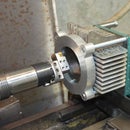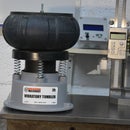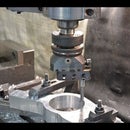Introduction: Improvements to My Lathe Tailstock.
This is my first Instructable but far from my first project.
This project is how I modified my tailstock so that it maintains its alignment over time and also makes alignment easier. My next instructable will show my method for the actual alignment which is somewhat different from the conventional methods.
Here is the link to the follow on post
https://www.instructables.com/id/Aligning-a-Lathe-Tailstock-with-a-Difference/
Step 1: The Problem.
Tailstocks are generally made from two main pieces in order to allow lateral displacement when turning a taper between centres. The photos show the two main pieces separately.
Adjustability means that an alignment process is necessary when turning parallel between centres and for drilling and reaming type applications. Tailstocks need a clamping method to hold them fixed to the lathe bed when working. Many lathes also use this global clamp as the only means of holding the two sections together. It has been my experience that this method of clamping leads to varying alignment between clamped and unclamped conditions. This makes alignment difficult, time consuming and tedious.
Step 2: The Solution
The solution was to drill and tap four bolt holes to enable the two sections to be clamped together independently, not relying on the clamping bolt or cam lock which holds the assembly to the lathe bed. This approach prevents the joint, between the two halves, from being released and tightened repetitively each time the tailstock is moved and re-clamped.
Materials used
- 4 x 6mm bolts (1/4" is OK and 8 mm or 5/16" might be better for larger lathes)..
Tools needed
- Drill bits and thread taps to suit the bolt choice above.
- As a bare minimum you could do this with nothing more than a pistol drill, but a drill press is much more convenient.
- A tap wrench or tapping machine.
- A milling machine is useful for spot facing but is far from essential.
Step 3: Machining 1
The first step was to drill the clearance holes in the upper part. This was done in a drill press. The bolt pattern was not quite symmetrical to match the top surface space.
Step 4: Machining 2
Once drilled the two halves were reunited a transfer punch was used to transfer the hole positions to the lower part, for drilling and tapping.
Step 5: Machining 3
Drilling the tapping holes in the lower section.
Step 6: Machining 4
Tapping the 6 mm holes in the base. I will make another instructable showing the construction of the hand tapping machine. A simple tap wrench would do the same job but in that case be careful to tap the holes square to the surface. Use a tapping guide if available.
Step 7: Machining 5
Spot facing the holes in the top section in a milling machine with a long tool.
Step 8: Ready for Alignment
Here we see the finished and assembled tailstock ready for alignment.
Step 9: The Movies.
I videoed the work flow as I made the modifications and the best way to understand what I did, and why, is to watch the 10 minute video.
BTW.the manual tapping machine shown in the video is described in this video.
If like the videos please like, share and subscribe to my channel for news of other workshop videos.
https://www.youtube.com/c/motochassistonyfoale
Step 10: Summary
I found the subsequent alignment to proceed more easily than it ever did with the standard arrangement. I am confident that the alignment will be more stable over time also. It was well worth the minimal amount of work involved.
here is the link to the follow on post.











